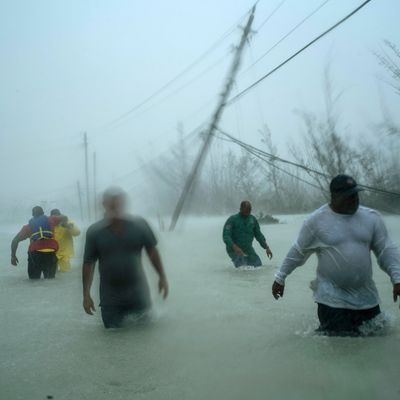
Hurricane Dorian stalled over several islands in the Bahamas as a Category 5 storm on Sunday and Monday, causing profound damage to the archipelagic country with a population just under 400,000. According to forecasters, the storm came to a halt after a high-pressure ridge pushing the storm westward died out, leaving the hurricane in a “holding pattern” over Grand Bahama island, where it thrashed with sustained wind speeds of 185 mph and a storm surge as high as 23 feet. On Tuesday, Prime Minister Hubert Minnis called Dorian “the greatest national crisis in our country’s history.”
On Thursday, the death toll rose to 30, though it is expected to climb even higher. Dr. Duane Sands, the Bahamas’ minister of health, told reporters that the number of casualties “could be staggering.” Sands added:
“We are embalming bodies so that we have more capacity as new bodies are brought in. We need to get coolers into Abaco and Grand Bahama, because we believe that we may not have the capacity to store the bodies.” As of Thursday, there was no official number for those displaced by the storm.
During the storm, images showed staggering levels of flooding and rainfall, with as much as 30 inches falling in some areas. The Grand Bahama International Airport in Freeport, the archipelago’s second-largest city, was five feet underwater.
On the Abaco island chain — less developed than the tourist areas of the country and populated by fishermen and Haitian migrants — thousands of homes are expected to have been damaged or destroyed.
On Tuesday, as the storm crept up the U.S. coast and southern states began to prepare for a weakened, but still potentially deadly, Category 2 storm, the accounting of the damage in the Bahamas began. The level of flooding from the enormous storm surge appeared to encompass close to half of the island of Grand Bahama.
Abaco, too, was suffering from major flooding and devastating property damage. A Red Cross spokesman told the Associated Press that it is believed that 13,000 houses — nearly half of all the homes on Grand Bahama and Abaco — suffered severe damage or were entirely destroyed.
U.N. officials say that over 60,000 people on the two islands need emergency food access, and that around 62,000 need access to clean water. The main hospital on Grand Bahama is reportedly unusable, while the hospital on Abaco desperately requires food, water, and medical supplies.
Lia Head-Rigby, the operator of a hurricane-relief organization on the island, told the AP that on Abaco there is “total devastation. It’s decimated. Apocalyptic. It looks like a bomb went off. It’s not rebuilding something that was there. We have to start again.”
According to a contact on the island that spoke with her, there are “a lot more dead” than reported. Rescue efforts began Tuesday, and largely involved Bahamians aiding each other — some used their Jet Skis to rescue people trapped on their roofs. Many shelters were also reportedly flooded or damaged, so housing victims will be another major challenge. On the island of Grand Bahama, over 400 people took refuge in the Grand Lucayan Resort and Casino.
Docks throughout the island were destroyed, and according to the Hope Town Volunteer & Fire Rescue, most docks on Abaco were destroyed, and 99 percent of boats were sunk on Elbow Cay.
Prime Minister Hubert Minnis called the damage from Dorian, the strongest storm to ever hit the Bahamas, “unprecedented.” The Bahamian minister of foreign affairs, Darren Henfield, said multiple unconfirmed casualties have been reported. “We have reports of bodies being seen,” Henfield said. “We cannot confirm those reports until we go out and see for ourselves.”






























